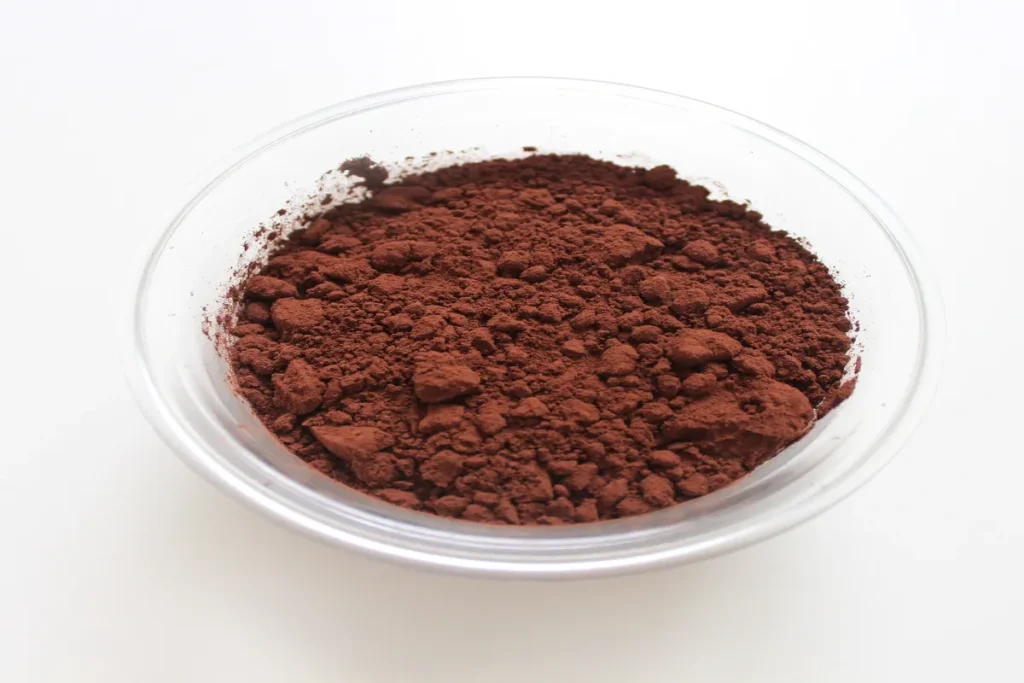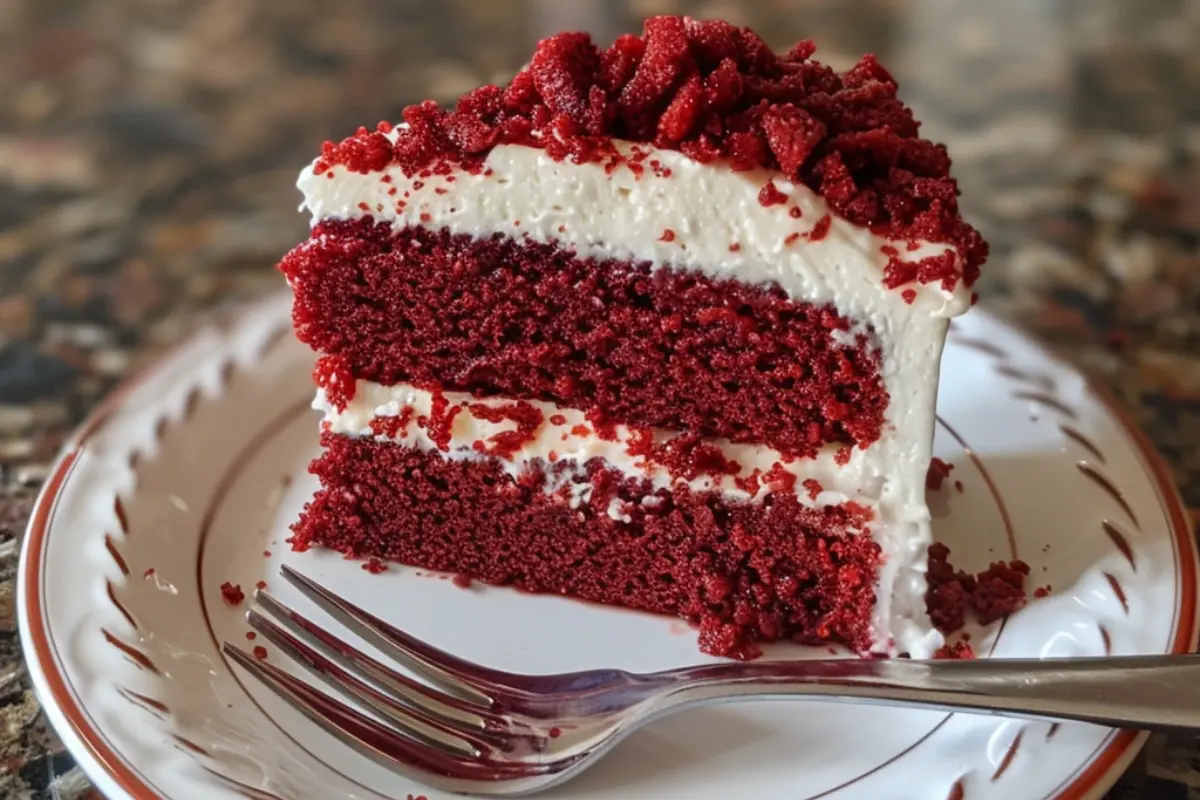Red velvet cake is a beloved dessert known for its striking red hue, velvety texture, and unique flavor profile. One of the key ingredients in this iconic cake is vinegar, a seemingly unusual addition to a cake recipe. So, why exactly do you put vinegar in red velvet cake? This article delves into the history, science, and essential role that vinegar plays in creating the rich, complex flavors and textures of this classic cake.
The Historical Significance of Vinegar in Red Velvet Cake
Origins of Red Velvet Cake
The history of red velvet cake dates back to the 19th century. Bakers originally used the term “velvet” to describe cakes with a soft, fine crumb, achieved through ingredients like cocoa powder, buttermilk, and vinegar. These early velvet cakes featured a reddish-brown color, resulting from the natural cocoa powder reacting with acidic ingredients like buttermilk and vinegar.
The modern red velvet cake emerged in the early 20th century. During this period, the use of vinegar in red velvet cake became widespread, particularly in the Southern United States. The Waldorf-Astoria Hotel in New York City often receives credit for popularizing the cake, though it was also a staple in Southern households.
Evolution of the Recipe
The original red velvet cake recipes did not rely on food coloring. Instead, the reaction between the cocoa powder, vinegar, and buttermilk gave the cake a natural reddish hue. However, during World War II, when food shortages made ingredients like cocoa scarce, bakers began to use beet juice and later, red food coloring, to enhance the cake’s color. The addition of red food coloring turned the cake into the vibrant red dessert we recognize today.
For a deeper dive into the origins of red velvet cake and how vinegar became a crucial ingredient, you can check out The Kitchn’s detailed exploration of red velvet cake. This resource provides insights into how vinegar, paired with natural cocoa powder, was a significant factor in the cake’s development.
For those looking to take their red velvet cake to the next level, why not try making a bundt version? Learn all the tips and tricks for How to Make the Perfect Red Velvet Bundt Cake to impress at your next gathering. This guide will help you master the bundt cake version, ensuring the same rich flavor and tender texture.
The Role of Vinegar in Baking Chemistry
Vinegar as a Leavening Agent
Vinegar is a key ingredient in red velvet cake due to its role as a leavening agent. When combined with baking soda, vinegar produces carbon dioxide gas, which helps the cake rise and gives it a light, fluffy texture. This chemical reaction is crucial for achieving the cake’s signature tender crumb.
- How It Works: When vinegar (an acid) reacts with baking soda (a base), the reaction releases carbon dioxide. This gas forms bubbles in the batter, causing it to expand and rise during baking. The result is a cake that is airy and light, with a fine, smooth crumb.
- Why Vinegar: Bakers often prefer vinegar in red velvet cake over other acidic ingredients like lemon juice or buttermilk. Vinegar’s neutral flavor doesn’t interfere with the cake’s other flavors, making it an ideal choice for maintaining the cake’s unique taste.
Understanding the role of vinegar in baking can also shed light on why it is such an essential ingredient in many cakes, not just red velvet. If you’re interested in how vinegar interacts with other ingredients in baking, this article from Baking Kneads provides a comprehensive look at vinegar’s function in the baking process.
Vinegar and Cocoa Powder Interaction
One of the unique aspects of red velvet cake is its use of natural cocoa powder, which is acidic. Unlike Dutch-processed cocoa, which has been alkalized to neutralize its acidity, natural cocoa powder reacts with vinegar to create the cake’s characteristic flavor and color.
- The Science Behind It: Natural cocoa powder contains compounds called anthocyanins, which are responsible for the color in many fruits and vegetables. When these anthocyanins react with the acidic vinegar, they can contribute to the cake’s reddish tint, though modern recipes often rely on food coloring to achieve a more vivid red hue.
- Enhancing Flavor and Texture: The reaction between vinegar and cocoa powder also enhances the cake’s flavor, giving it a subtle chocolate taste without being overpowering. Additionally, this reaction helps create a moist, tender crumb, which is a hallmark of red velvet cake.

For more information on how to achieve the perfect color in red velvet cake, this resource from Mashed offers tips on color preservation and the use of different types of food coloring.
One of the reasons vinegar is added to red velvet cake is its interaction with natural cocoa powder. This interaction contributes not only to the cake’s rise but also to its distinctive flavor. If you’re curious about the overall unique taste of red velvet cake, you might want to explore further in What Makes Red Velvet Cake Taste Different?.
Vinegar and Cake Color Preservation
The Importance of Acid in Color Retention
One of the reasons vinegar is used in red velvet cake is its ability to help preserve the cake’s vibrant red color during baking. The acidity of vinegar plays a crucial role in stabilizing the color, ensuring that the cake remains bright and appealing even after it comes out of the oven.
- Preventing Browning: Without an acidic environment, the natural pigments in cocoa powder can turn brown during baking. Vinegar helps maintain the desired red color by lowering the pH of the batter, which stabilizes the pigments and prevents them from breaking down.
- Modern Food Coloring: While traditional red velvet cakes relied on the natural reaction between cocoa powder and vinegar for their color, most modern recipes use red food coloring to achieve a more consistent and vivid hue. The vinegar still plays a crucial role in ensuring that the food coloring maintains its vibrancy during baking.
The Role of Vinegar in Texture and Moisture
In addition to its impact on color, vinegar also contributes to the texture and moisture of red velvet cake. The acidity of vinegar interacts with the other ingredients in the batter to create a cake that is not only visually appealing but also deliciously tender and moist.
- Enhancing Moisture: The acidic environment created by vinegar helps break down the proteins in the flour, which results in a softer, more tender crumb. This process, known as protein denaturation, is essential for creating the smooth, velvety texture that red velvet cake is known for.
- Balancing Flavors: Vinegar also plays a role in balancing the flavors of the cake. While red velvet cake is sweet, the addition of vinegar adds a subtle tanginess that complements the sweetness and adds depth to the overall flavor profile.
Substituting Vinegar in Red Velvet Cake
Alternative Acids in Baking
While vinegar is traditionally used as the acid in red velvet cake, several alternatives can replace it if vinegar is unavailable or if you want a different flavor profile.
- Lemon Juice: Lemon juice is a common substitute for vinegar in baking because it has a similar acidity level. However, it also has a strong flavor that can alter the taste of the cake, making it a less neutral option.
- Buttermilk: Buttermilk is another alternative that provides both acidity and moisture. Many red velvet cake recipes already include buttermilk, so substituting vinegar with buttermilk might require adjustments to the other liquid ingredients to maintain the correct consistency.
- Cream of Tartar: Bakers often use cream of tartar, a dry acid, as a substitute for vinegar in baking. It typically combines with baking soda to achieve the same leavening effect as vinegar. However, since it lacks the liquid component that vinegar provides, you may need to add extra liquid to the recipe to maintain the desired consistency
Impact on Flavor and Texture
Substituting vinegar in red velvet cake can affect both the flavor and texture of the cake, depending on the substitute used.
- Flavor Changes: Using lemon juice instead of vinegar will add a citrusy note to the cake, which may not be desirable in all recipes. Buttermilk, on the other hand, will maintain the tangy flavor of the cake but may make it slightly richer and creamier.
- Texture Adjustments: The substitute you use can also affect the cake’s texture. For example, replacing vinegar with buttermilk may produce a slightly denser cake. Using cream of tartar, however, could result in a drier cake if you don’t add enough liquid to the batter.
Frequently Asked Questions
Why is vinegar necessary for red velvet cake?
- Vinegar is necessary because it reacts with the baking soda to help the cake rise, creating a light, fluffy texture. It also interacts with the cocoa powder to enhance the cake’s color and flavor, giving red velvet cake its distinctive appearance and taste.
Can you make red velvet cake without vinegar?
- Yes, you can substitute vinegar with other acidic ingredients like lemon juice, buttermilk, or cream of tartar. However, this may slightly alter the cake’s flavor and texture, so it’s important to adjust the recipe accordingly to maintain the desired outcome.
What kind of vinegar is best for red velvet cake?
- Bakers typically use white vinegar because it has a neutral flavor that doesn’t interfere with the cake’s other ingredients. Apple cider vinegar can serve as an alternative, but it may impart a slight fruity taste that could alter the cake’s flavor profile.
How does vinegar affect the color of red velvet cake?
- Vinegar helps preserve the vibrant red color of red velvet cake by lowering the pH of the batter and stabilizing the pigments in the cocoa powder and food coloring. This prevents the cake from browning during baking and ensures that it retains its striking red hue.
Is vinegar used in other types of cakes?
- Yes, bakers use vinegar in a variety of cakes, especially those that need a tender crumb or a light, fluffy texture. In chocolate cakes, vinegar reacts with baking soda to enhance the cake’s rise and improve its texture. Many recipes for pound cakes, sponge cakes, and other baked goods include vinegar, where it serves as an acidic ingredient to balance flavors and create the desired consistency.
Is vinegar used in other types of cakes?
Yes, bakers often include vinegar in a variety of cakes, especially those requiring a tender crumb or a light, fluffy texture. In chocolate cakes, vinegar reacts with baking soda to enhance the cake’s rise and improve its texture. Many recipes for pound cakes, sponge cakes, and other baked goods also incorporate vinegar. It serves as an acidic ingredient that balances flavors and creates the desired consistency.
Conclusion
Vinegar plays a crucial role in red velvet cake, affecting everything from the cake’s rise and texture to its color and flavor. By understanding why vinegar is used in red velvet cake, you can appreciate the chemistry that makes this dessert so unique. Whether you’re a seasoned baker or trying red velvet cake for the first time, knowing the importance of vinegar will help you achieve the perfect cake every time.
Vinegar’s ability to react with baking soda, enhance the cocoa powder’s natural color, and contribute to a tender crumb makes it indispensable in the classic red velvet recipe. As you experiment with different variations of red velvet cake, you’ll find that vinegar remains a consistent and vital ingredient in achieving the perfect balance of flavors and textures.

